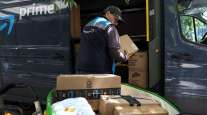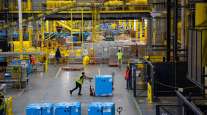Senior Reporter
New DHL Report Focuses on Strong Growth of E-Commerce

[Stay on top of transportation news: Get TTNews in your inbox.]
The post-COVID-19 economy will continue to rely more on e-commerce and emphasizing the importance of final- and mid-mile delivery services at the same time as the logistics industry is being pushed to become more sustainable and develop better, cleaner methods of getting items to consumers faster.
That’s the conclusion of a new white paper report from DHL and FINN Partners’ Global Supply Chain, Logistics and Transportation Practice called “E-commerce: How Online Retail Can Build the Sustainable Supply Chain of Tomorrow,” released June 1.
“E-commerce is fundamentally reshaping our customers’ supply chains, challenging them to redesign their transportation and warehousing networks in order to accommodate customer demand across multiple channels, address changes in trade and inventory flows, and be more responsive to the market,” said Kraig Foreman, DHL Supply Chain president of e-commerce in North America.

Foreman
“E-commerce as a percentage of retail sales has moved forward five to seven years from what we expected, just in the last year," he added. "And, we have that disruption in the supply chain, where you are moving those trends so fast, you need to have a calibration of your supply chain and your strategy.”
The report says for the trucking and logistics industry, growth of final-mile delivery has been explosive. In 2018, consumers spent $31.2 billion for delivery-related service. By 2022, that number will have grown by more than 60% to nearly $51 billion.
The report makes five recommendations to improve final-mile efficiency and make it more environmentally sustainable:
• Shift more deliveries to off-peak hours, when there is less congestion on roads, and allow for the use of larger trucks to reduce the number of trips back and forth to warehouses.
• Increase the use of route optimization programs to find the best way to get from point to point and shorten dwell times at warehouses.
ECO-mmerce_DHL White Paper by Transport Topics on Scribd
• Use more load pooling that matches the demand for capacity with available supply to increase vehicle loads. A 2017 study by the McKinsey Center for Business and Environment said that load pooling in urban areas, if used more extensively, could reduce delivery costs by as much as 25% and cut vehicle emissions by 30%.
• Expand the use of consolidated drop-off locations at stores or parcel lockers, where customers can pick up packages at any time, which the report said would reduce the number of failed deliveries.
• Increase the use of autonomous vehicles, as DHL and other package delivery companies are doing. The report said that, when paired with electric vehicles, these deliveries could be “extremely sustainable.”
DHL’s report was released to mark the annual World Environmental Day on June 5, which, since 1974, continues to be the United Nations’ main vehicle to support environmental awareness.
In March, DHL released its new corporate sustainability road map outlining the company’s goal to be a zero-emission business by 2050.
Survey Says
A survey of consumers conducted for DHL by Morning Consult found:
54% indicated their online shopping habits increased during the pandemic.
60% are willing to pay more for environmentally friendly products or services.
54% stated they put more trust in a company based on the business’ public commitment to environmental sustainability.
By 2030, DHL said it will have 80,000 electric vehicles on the road making last-mile deliveries, and that will be 60% of its global fleet.
“Our ability to hit that 2050 zero-emission goal, or more importantly, the midterm goal of 2030, is going to come down to three things,” DHL Express CEO Greg Hewitt said on a conference call with reporters June 1.
• What can be done about energy, e-vehicles, last mile, to improve upon what is done today.
• Enhanced efficiency, or using less fossil fuels than currently are consumed.
• Regarding eco-materials and packaging, changes that allow for improvement on those goals.
According to a 2018 report from the U.S. Environmental Protection Agency, containers and packaging were responsible for 83 million tons of solid waste. At the same time, because of increasing the use of recycled materials, the recycling rate of packaging and containers reached nearly 54%. That was up from 49.4% in 2017.
The report said many companies are building more and smaller warehouses and fulfillment centers to hold inventory closer to consumers, and retailers and logistic providers also are working to reduce the weight of packaging and ways they are loaded onto trucks to make them more efficient.
“The desire for more eco-friendly packaging also extends to the materials stuffed inside the boxes to prevent damage,” the report said. “Companies are looking more holistically at this, balancing the need to ensure their products’ integrity during transport with reducing waste.”
Want more news? Listen to today's daily briefing below or go here for more info:




